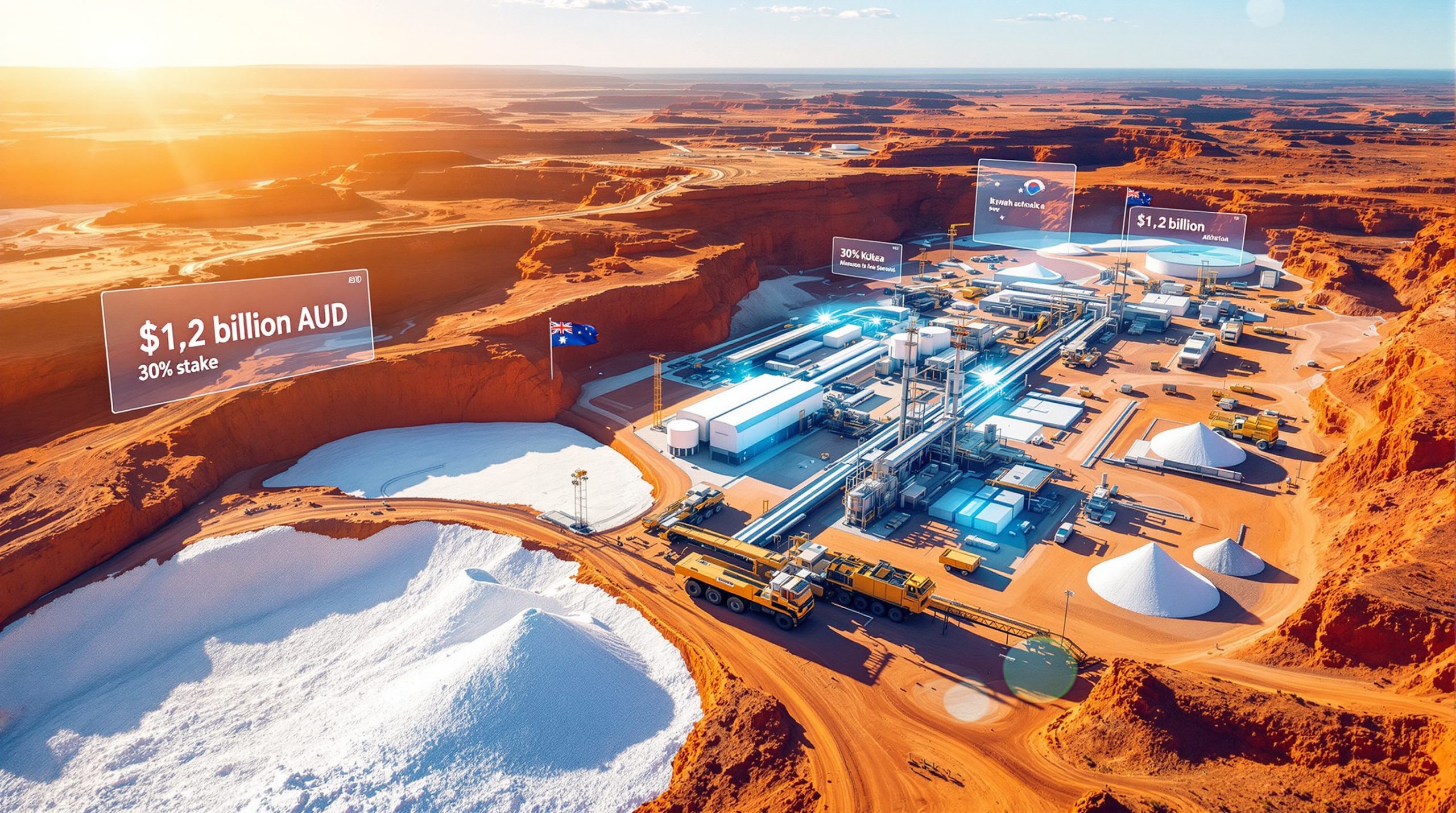What Does the U.S.-Pakistan Rare Earth Agreement Mean for Global Markets?
The emergence of Pakistan as a strategic partner in America's critical minerals diversification strategy represents a fundamental shift in global supply chain architecture. This U.S. miner in Pakistan rare earth collaboration follows closely after the United States unveiled its Malaysia-centered ASEAN critical minerals initiative, signaling Washington's commitment to reducing dependence on Chinese rare earth dominance through South Asian geological resources. Furthermore, these developments align with broader energy transition security objectives across multiple regions.
Nova Minerals Ltd, an ASX-listed exploration company with operations spanning from Alaska to South Asia, recently engaged with Pakistan's Board of Investment to explore opportunities in antimony, rare earths, and gold. This meeting, though receiving modest media coverage, carries profound strategic implications for global U.S. miner in Pakistan rare earth partnerships. In addition, these discussions provide valuable strategic antimony insights that inform broader critical minerals strategies.
Key Partnership Metrics:
- Primary Focus: Neodymium, praseodymium, antimony, and copper
- Development Approach: Joint ventures, technology transfer, and knowledge exchange
- Timeline Expectation: 7-10 years for significant processing capacity development
- Geographic Scope: Khyber Pakhtunkhwa and Balochistan provinces
According to the U.S. Geological Survey, global rare earth element production in 2024 was approximately 890,000 metric tons of rare earth oxide equivalent, with China accounting for approximately 70% of global production. This dominance has created strategic vulnerabilities that Western nations are actively addressing through partnerships like the emerging Pakistan collaboration. Consequently, these initiatives contribute to establishing a comprehensive critical minerals reserve strategy.
Strategic Minerals at the Center of Cooperation
The collaboration prioritises elements essential for defense applications, renewable energy infrastructure, and advanced manufacturing. Pakistan hosts known occurrences of antimony, rare earth-bearing pegmatites, and clay-hosted REE analogues, particularly in regions that mirror successful extraction operations elsewhere.
Board of Investment Chairman Qaiser Ahmed Sheikh emphasised Pakistan's vast, untapped potential and pledged full facilitation for foreign investors committed to value addition, local processing, and advanced technical collaboration. This represents a significant policy shift from traditional raw material exports toward domestic value-added processing. However, implementing modern mining technology remains crucial for achieving these ambitious processing goals.
Neodymium and praseodymium, critical for permanent magnets in wind turbines and electric vehicles, represent the highest-value components of this emerging trade relationship. The International Energy Agency projects global demand for NdPr will increase from approximately 50,000 tonnes in 2020 to over 85,000 tonnes by 2030, driven primarily by clean energy transitions.
How Pakistan's Geological Wealth Positions It as a Critical Minerals Hub
Pakistan's mineral endowment spans multiple provinces, with Balochistan hosting the most significant rare earth deposits. The country's geological diversity includes pegmatite formations and clay-hosted REE analogues that offer promising exploration targets for Western mining companies seeking alternatives to Chinese-controlled resources.
Provincial Distribution of Key Resources:
| Province | Primary Minerals | Geological Formation | Development Status |
|---|---|---|---|
| Balochistan | REEs, Copper, Gold | Pegmatites, Sedimentary | Early Exploration |
| Khyber Pakhtunkhwa | Antimony, REEs | Metamorphic, Igneous | Initial Assessment |
| Punjab | Industrial Minerals | Sedimentary | Limited Survey |
| Sindh | Copper, Coal | Sedimentary | Preliminary Studies |
The geological formations in these provinces have characteristics similar to successful rare earth operations in other regions, though specific target districts, licensing details, and environmental frameworks remain to be fully documented. This early-stage status reflects typical patterns in emerging mineral provinces where initial diplomatic engagement precedes detailed technical assessment.
Infrastructure Challenges and Development Timeline
Current extraction capabilities remain limited to basic ore production, requiring substantial investment in processing and refining infrastructure. Pegmatite-hosted rare earth deposits typically contain REE concentrations of 0.1% to 2.0% total rare earth oxides, depending on mineralogy and pegmatite type.
Processing requires several stages:
- Beneficiation: Physical concentration through flotation or gravity separation
- Acid or Alkaline Leaching: Chemical extraction of REE from ore concentrates
- Solvent Extraction: Separation of individual rare earth elements
- Purification: Achievement of commercial-grade rare earth products
According to the International Energy Agency, there are currently no commercial rare earth separation facilities operating in Pakistan, creating opportunities for technology transfer and joint venture development. The phased development approach would prioritise immediate export of concentrates while building domestic value-addition capacity.
Industry experts estimate 5-7 years for meaningful processing capacity development, with initial concentrate exports providing revenue during infrastructure construction phases. This timeline aligns with similar developments in Southeast Asia, where Malaysia's Lynas facility required approximately 5 years from construction start to full commercial operation.
Why Western Companies Are Targeting Pakistan's Mining Sector Now
The timing of increased Western interest in Pakistani minerals aligns with broader geopolitical shifts in critical materials sourcing. The U.S. Department of Defense issued a Critical Materials Strategy in 2022 identifying rare earth elements as strategic vulnerabilities, accelerating Western company interest in non-Chinese supply sources. Moreover, these developments reflect ongoing US-China trade impacts on global supply chain strategies.
Companies like Nova Minerals are exploring opportunities beyond traditional mining jurisdictions, seeking geological diversity outside China's sphere of influence. Nova's portfolio includes the Estelle Gold Project in Alaska alongside proven exploration capabilities that position the company for international expansion.
Factors Driving Investment Interest:
- Policy Reform: Pakistan's shift from raw material exports to value-added processing
- Geological Potential: Underexplored regions with favourable mineral indicators
- Strategic Location: Proximity to both Middle Eastern and Asian markets
- Government Support: Board of Investment facilitation for foreign partnerships
- Supply Chain Diversification: Reduced dependence on single-source suppliers
This outreach represents what industry analysts describe as private Western firms testing new geological frontiers outside China's traditional orbit of influence. The strategic implications extend beyond commercial considerations, potentially shifting the mineral architecture of South Asia.
Technology Transfer and Joint Venture Models
Modern mining partnerships emphasise knowledge exchange, local capacity building, and shared technical expertise. Standard structures for minerals partnerships in emerging markets include:
- Exploration Phase: Foreign operator maintains majority ownership during initial development
- Development Phase: Gradual transition to increased local participation
- Production Phase: Revenue-sharing models tied to production milestones
- Technology Transfer: Mandatory training programmes for local workforce development
According to World Bank guidelines, successful joint venture models typically require 3-5 year technology transfer commitments, ensuring sustainable local capacity development alongside commercial production goals.
How Does This Partnership Compare to Other U.S. Critical Minerals Initiatives?
The Pakistan collaboration operates alongside America's ASEAN critical minerals initiative, creating a multi-regional approach to supply chain diversification. While the Malaysia-centred programme focuses on treaty-aligned guarantees and established processing capabilities, the Pakistan partnership explores private-sector geological frontiers.
Comparative Analysis of U.S. Critical Minerals Strategies:
Southeast Asian Approach: Government-to-government agreements with established processing capabilities
South Asian Strategy: Private investment in early-stage geological development
African Initiatives: Focus on lithium and cobalt through development finance
Latin American Programmes: Emphasis on lithium triangle resources and processing partnerships
The U.S. International Development Finance Corporation has invested approximately $500 million to support cobalt mining in the Democratic Republic of Congo as part of supply chain diversification strategy. Meanwhile, Latin American partnerships focus on the lithium triangle comprising Argentina, Bolivia, and Chile, which together host approximately 58% of global lithium reserves.
Recent developments demonstrate this diversification strategy's effectiveness. According to SFA Oxford's analysis, Pakistan's rare earths partnership significantly advances U.S. supply chain security and independence, marking a pivotal shift in global mineral sourcing strategies.
Integration with Broader Supply Chain Security Goals
These parallel initiatives create redundancy and resilience in critical materials sourcing, reducing single-point-of-failure risks that have historically characterised rare earth supply chains. The United States is currently 100% import-dependent for rare earth elements, with approximately 80% of imports historically sourced through China or China-processed materials.
Emerging alternative sources include Australia for rare earth mining, Malaysia for processing, and Japan for recycling, with Pakistan potentially adding another dimension through combined mining and processing capabilities in South Asia. Furthermore, recent reports from Reuters confirm that the U.S. will explore cooperation with Pakistan on critical minerals and hydrocarbons, solidifying this strategic partnership.
What Are the Technical and Economic Challenges Facing Pakistan's Mining Development?
Despite significant geological potential, Pakistan faces substantial hurdles in transforming mineral wealth into commercial production. Processing infrastructure, skilled workforce development, and environmental frameworks require coordinated investment and policy support.
Critical Development Requirements:
- Processing Facilities: Rare earth separation and purification plants
- Transportation Infrastructure: Rail and port connections for bulk materials
- Technical Expertise: Metallurgical engineering and processing specialists
- Environmental Systems: Waste management and water treatment capabilities
- Regulatory Framework: Mining codes and environmental permitting processes
- Security Infrastructure: Protection of operations in remote mining regions
REE processing requires substantial freshwater, typically 1-3 tonnes of water per tonne of ore processed. Water availability assessment in Balochistan and Khyber Pakhtunkhwa becomes critical for project feasibility, particularly given regional climate challenges.
Investment Timeline and Capacity Building
Commercial rare earth mining projects typically require 10-15 year development timelines in emerging markets. Indonesia's Bayan Resources rare earth project illustrates typical progression: exploration began 2010, first resource estimate 2017, feasibility study 2021, with development continuing as of 2024.
Development Phase Milestones:
- Geological Survey and Resource Estimation (Years 1-3)
- Feasibility Studies and Environmental Impact Assessment (Years 3-5)
- Infrastructure Development and Plant Construction (Years 5-8)
- Commissioning and Production Ramp-up (Years 8-10)
- Full Commercial Operation and Market Integration (Years 10+)
How Will Resource Nationalism Trends Affect Pakistan's Mining Strategy?
Pakistan's emphasis on local value addition reflects global trends toward resource nationalism, similar to policies implemented in Indonesia, Malaysia, and Saudi Arabia. This approach prioritises domestic job creation and industrial development over raw material exports.
Indonesia's resource nationalism model provides relevant precedent. Mining law reforms implemented between 2009-2014 required foreign mining companies to maintain maximum 49% ownership in early exploration phases, transition to 51% local ownership by production start date, and invest in domestic smelting/refining infrastructure.
Resource Nationalism Implementation Strategies:
- Export Restrictions: Limitations on unprocessed ore exports
- Local Content Requirements: Mandatory domestic value addition
- Technology Transfer Mandates: Knowledge sharing obligations for foreign investors
- Joint Venture Structures: Shared ownership with local partners
- Processing Infrastructure Requirements: Domestic refining capacity development
Balancing Foreign Investment with National Interests
Successful implementation requires careful balance between attracting international capital and maintaining sovereign control over strategic resources. Malaysia's approach with Lynas Rare Earths demonstrates effective partnership structures, where foreign technology and investment combine with local regulatory oversight and workforce development.
This framework attracted major Western mining companies while creating operational frameworks that support both commercial viability and national development objectives. Consequently, this model provides valuable insights for the developing U.S. miner in Pakistan rare earth partnerships.
What Security and Geopolitical Considerations Shape This Partnership?
The U.S. miner in Pakistan rare earth cooperation operates within complex regional security dynamics, particularly regarding China's Belt and Road Initiative presence in the region. Strategic materials partnerships often carry broader geopolitical implications beyond commercial considerations.
Regional Security Factors:
- China-Pakistan Economic Corridor: Existing Chinese infrastructure investments
- India-Pakistan Relations: Regional tensions affecting cross-border trade
- Afghanistan Proximity: Security concerns in border regions
- Middle East Connections: Trade route access and energy partnerships
- Port Access: Karachi and Gwadar facilities for bulk materials export
The China-Pakistan Economic Corridor represents approximately $62 billion in pledged Chinese investments, creating complex dynamics for Western mining partnerships. Balancing these relationships requires careful diplomatic navigation while maintaining commercial objectives.
Strategic Autonomy and Supply Chain Resilience
Both countries benefit from reduced dependence on single-source suppliers, though implementation requires careful navigation of existing regional relationships. Pakistan gains access to Western technology and markets, while the United States diversifies critical materials sourcing away from Chinese-controlled supply chains.
If even one credible REE district in Pakistan is brought into Western development pipelines, it could meaningfully shift the mineral architecture of South Asia, a region historically integrated into Chinese mining and metallurgical networks.
Frequently Asked Questions About U.S.-Pakistan Rare Earth Cooperation
What specific rare earth elements does Pakistan produce?
Pakistan's geological formations contain neodymium and praseodymium concentrates, along with antimony and copper. Future development may expand to include dysprosium, terbium, and other heavy rare earth elements pending detailed resource assessment and metallurgical testing.
How long will it take for Pakistan to become a major rare earth supplier?
Industry analysts project 7-10 years for significant processing capacity development, with meaningful concentrate exports beginning within 2-3 years of sustained investment. Full supply chain integration typically requires decade-plus timelines for greenfield rare earth projects.
What role do Chinese companies play in Pakistan's mining sector?
While Chinese firms maintain presence through CPEC projects and traditional bilateral relationships, the new U.S. partnership represents diversification toward Western technology and markets. This creates complex dynamics requiring careful diplomatic and commercial navigation.
How does this affect global rare earth prices?
Increased supply diversity typically moderates price volatility and reduces single-source supplier risks. However, meaningful market impact requires substantial production volumes that may take years to achieve through new project development.
What environmental considerations affect Pakistan's rare earth development?
REE processing generates radioactive thorium-bearing tailings requiring specialised disposal infrastructure. Environmental baseline studies and water management systems become critical components of sustainable development frameworks.
Future Outlook: Pakistan's Position in Global Critical Minerals Markets
The success of U.S.-Pakistan minerals cooperation will largely determine whether Pakistan emerges as a significant player in global critical materials markets. Early indicators suggest positive momentum, but sustained investment and policy support remain essential for long-term success.
Success Factors for Market Integration:
- Consistent Investment: Sustained capital commitment through development phases
- Technical Expertise: Access to advanced processing technologies
- Market Access: Established trade relationships and logistics networks
- Regulatory Stability: Predictable policy environment for long-term planning
- Infrastructure Development: Transportation, power, and processing capabilities
- Workforce Training: Local capacity building and skills development
The partnership represents more than bilateral trade expansion. It signals a fundamental restructuring of global critical minerals geography, with South Asia potentially emerging as a key supply region alongside traditional producers in China, Australia, and Africa.
Early diplomatic signals suggest positive engagement, though technical validation through core sampling, resource modelling, and metallurgical testwork will ultimately determine commercial viability. The strategic implications extend beyond immediate commercial returns, potentially influencing regional geopolitical dynamics and global supply chain architecture.
Pakistan's shift from traditional raw material exports toward refining, upgrading, and industrial upscaling mirrors successful transformations in Malaysia, Indonesia, and other resource-rich nations. The combination of geological potential, government support, and Western technology transfer creates conditions for meaningful participation in global critical minerals markets.
Disclaimer: This analysis is based on publicly available information and industry assessments. Actual project development timelines, resource estimates, and commercial outcomes may vary significantly from projections. Readers should conduct independent research before making investment decisions related to critical minerals projects.
Ready to Capitalise on Emerging Critical Minerals Opportunities?
Discovery Alert's proprietary Discovery IQ model delivers real-time alerts on significant ASX mineral discoveries, instantly empowering subscribers to identify actionable opportunities in the rapidly evolving critical minerals sector ahead of the broader market. Understand why historic discoveries can generate substantial returns by visiting Discovery Alert's dedicated discoveries page, showcasing exceptional outcomes from major mineral finds, and begin your 30-day free trial today to position yourself ahead of the market.




